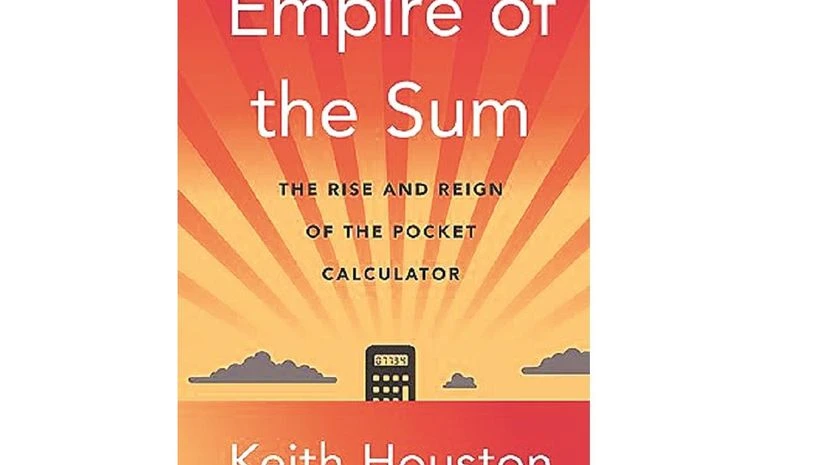EMPIRE OF THE SUM: The Rise and Reign of the Pocket Calculator
Author: Keith Houston
Publisher: W W Norton
Pages: 373
Price: $32.50
Also Read
Earlier this year, my seven-year-old lugged home a TI-89 graphing calculator, an updated version of the legendary models from Texas Instruments that were once the must-haves of every serious high school calculus cowboy in America.
As far as I can tell, he hasn’t unsheathed the thing once, has not glimpsed the pixelated screen or the intimidating array of 50 keys below. Until recently, the TI calculators marked the pinnacle of humans’ quest to master computation. (You could play games like Astrosmash, too.) Yet in the digital age, they are becoming relics.
I was nevertheless comforted by the mere presence of the familiar rectangle, far too large to fit into the average high schooler’s pocket and lacking any pretensions to contemporary minimalism. Here was a tool that respected its users’ intelligence. Yeah, maybe you goofed off on Block Dude during a lesson on parametric equations, but for the most part this was and remains a business-in-the-front, business-in-the-back affair.
A marvel of engineering that benefited from a brilliant ad campaign, the TI series dominated a market it helped create. Only some two decades after the appearance of the first commercial hand-held calculator, the TI models came in the 1990s to enjoy what Keith Houston calls “utter ubiquity.” Now, my son’s abandoned TI-89 sits on my desk Ozymandias-like, a warning about what progress can create — and just as quickly leave behind.
“To live is to count, and to count is to calculate,” Houston writes in Empire of the Sum: The Rise and Reign of the Pocket Calculator, which tries to make an arcane subject accessible to people who have never considered the 17th-century mathematician John Napier’s insights into prosthaphaeresis. (This is a book that features the word “prosthaphaeresis” more than once.) Houston seems to relish such challenges, as good science writers do. His first book, Shady Characters, about “the secret life of punctuation,” was praised by one reviewer as “erotica for grammar geeks.”
It remains to be seen if Empire of the Sum will turn the history of base-10 numeration into a forbidden pleasure. To describe a calculator as a “symphony of solenoids and switches” (that would be an early, discarded model of what would become the Casio 14-A, which went on the market in 1957 for $1,347) may not be erotica, but it is good writing — and these days, the latter is rather more rare.
The story of the calculator is that of innovation and obsolescence, of the abacus giving way, in the 17th century, to the slide rule; mechanical devices like the arithmometer ceding to electronic ones like the Sumlock ANITA, powered by 177 cathode tubes. Silicon Valley-style disrupters abound, only instead of social media feuds, Houston brings us the medieval debate between algorists and abacists over whether to use Roman or Arabic numerals.
The first mechanical calculator for popular usage was designed by Curt Herzstark, a half-Jewish Austrian who spent time in the Buchenwald concentration camp. His invention, the Curta, looks like an exceptionally sleek meat grinder. A masterpiece of midcentury design, the Curta is still prized by collectors.
Houston’s narrative is full of oddballs, many of them brilliant, some of them brilliant and insufferable. I could have read an entire book about the 1946 computing competition between Pvt. Tom Wood, who used a calculator, and Kiyoshi “The Hands” Matsuzake, who employed a Japanese abacus called the soroban. I had no idea that the very notion of the algorithm comes from the ninth-century Arabic scholar al-Khwarizmi, or that there were two slide rules aboard the Enola Gay as it flew toward Hiroshima. Buzz Aldrin also carried a slide rule aboard the Apollo 11; it sold at auction for $77,675.
There are thorny stretches in Empire of the Sum. It is, after all, a book about math. On some level, you just have to accept that some of Houston’s references — to Boolean logic, or geometric progression — may be beyond your grasp. Then again, I don’t read to master everything, but, rather, to learn something.
I do wish that, once in a while, Houston climbed to a higher altitude, leaving behind the details of computational innovation to ask what all that innovation was for. Even before the advent of artificial intelligence programs like ChatGPT, the discipline had succumbed to a technology it helped pioneer: the computer.
“Which system will people turn to most often to balance their checkbooks or calculate the trajectory of a missile? Only time will tell,” this newspaper wondered in 1997, by which time calculator sales were already falling from the apex of 61.6 million units bought in 1989.
From time to time, my youngest son — the putative owner’s toddler brother — will try his luck with the TI-89, mashing its buttons and then waiting, in vain, for the glow of a smartphone display. The calculator’s microprocessor may be able to graph a logarithmic function, and there is also the modest delights of the aforementioned Astrosmash — but Cocomelon videos are beyond its scope. And so back into the plastic shell it goes.
The ancients grappled with the question of whether we always benefited from making tasks easier for ourselves. “Good mathematicians do not use counting rods,” the Chinese philosopher Lao Tzu declared some 2,500 years ago. No, not today. They just ask ChatGPT.
The reviewer is a writer based in Washington, DC ©2023 The New York Times News Service

)
